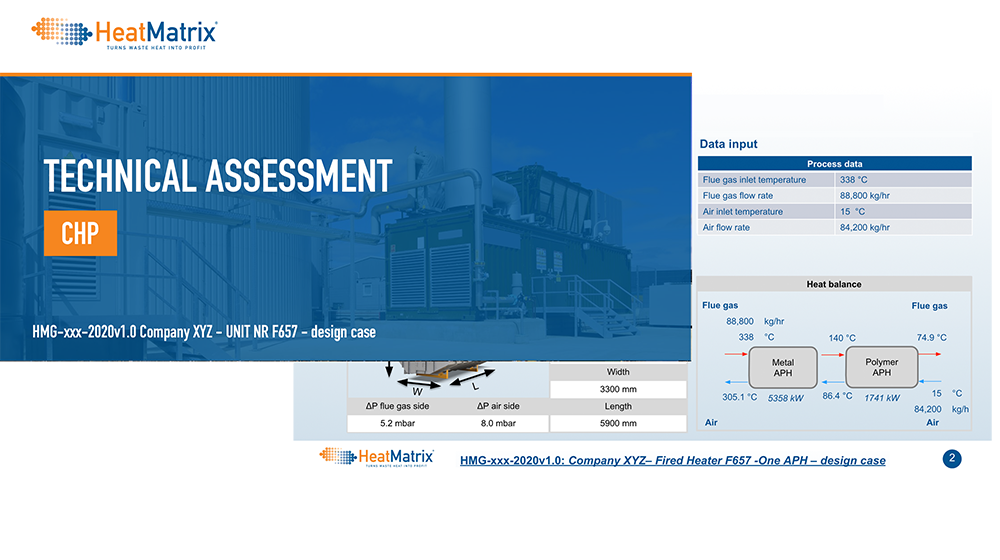Waste heat recovery from Combined Heat and Power (CHP) systems
Cold spot corrosion problems and mechanical failures limit heat recovery. Polymer economisers are corrosion resistant and designed for leak proof thermal expansion.
Your CHP has additional waste heat recovery potential

Improve CHP energy efficiency
The thermal efficiency of your CHP can be improved by using a polymer economiser.
Lower CHP CO2 emissions
Decrease CHP fuel costs
By recovering additional waste heat, less fuel is needed to achieve the required thermal duty of your CHP.
Waste heat recovery on CHP systems is limited by corrosion and mechanical failures
Energy is lost via the stack
A gas engine or gas turbine is used to generate power and heat. Waste heat from the flue gas is recovered to generate steam or hot water. A typical CHP is already equipped with an economiser to preheat boiler feed water. The flue gas temperature downstream of this economiser typically tends to be >120 °C, which means energy loss.
Cold Spot corrosion problems
Depending on fuel type, heat exchangers may suffer from cold spot corrosion due to relatively cold tube skin temperatures. This limits heat recovery. Enhancing further thermal efficiency is possible by installing a corrosion resistant economiser which recovers additional heat from the flue gas. This results in extra energy savings.
Mechanical failure
Conventional heat exchangers suffer from mechanical failure due to stresses that are developed by thermal expansion. This results in leaking equipment and loss of heat recovery.
How to recover more waste heat from your CHP
Use flue gas heat to warm up boiler feed, make-up or process water
The simplest and most economical way to improve the efficiency of your CHP is by applying an additional economiser to preheat boiler feed water, make-up water or process water. In case of flue gases with high acid dew points the stainless steel or polymer economiser of HeatMatrix can be applied. This economiser is insensitive to acid dew point corrosion and can recover energy from your flue gas under harsh conditions.
Waste heat recovery systems for a CHP
Stainless steel or Polymer Economiser
Warm up boiler feed water, make-up water or process water with waste heat from flue gas. The economiser is corrosion resistant & anti-fouling and is easy to maintain and clean.
Carlsberg
4% boiler efficiency increase
Within the Together Towards ZERO program, Carlsberg strives to make their breweries more sustainable. One of the steps taken in their Ukraine brewery is using a biogas fired steam boiler.
Due to the usage of biogas, high concentrations of sulphur elements can be found in the flue gas. If the flue gas is cooled down, these sulphur components condense and form sulphuric acid which is very corrosive. To prevent this from happening, Carlsberg operated their system such that the flue gas was at a high temperature (>140 °C) leaving the stack. Additional heat present in the flue gas was not used.
HeatMatrix installed a Polymer Air PreHeater which allowed Carlsberg to cool to temperatures below the acid dew point and achieve additional heat recovery on their steam boiler. There are no corrosion issues because of the corrosion resistance of the polymer used in the HeatMatrix APH. Based on the success in Ukraine, Carlsberg Serbia introduced the same solutiton on their biogas fired boiler.
Technical Assessment of your CHP
- Analysis of process data of your steam boiler
- Minimal input data required
- Business case on your savings potential

FAQ's
How does a Combined Heat and Power (CHP) system work?
What are Combined Heat and Power (CHP) systems used for?
CHP’s are used to generate electricity and heat at the same time using fuels like biogas, natural gas or other mixtures of fuel gases. A gas engine type CHP has a range up to 5 MW electricity whereas a gas turbine type CHP can go up to 50MW electricity on chemical complexes and up to 200MW electricity for the public power grid.
How does waste heat recovery on a Combined Heat and Power (CHP) system work?
The flue gases released from a CHP still have a temperature of 120º-150ºC despite the fact that flue gas heat exchangers are already being used to generate steam/hot water. The waste heat that is still present in the flue gas can be further recovered and reused. Even condensation energy of the flue gas can be recovered if a heat sink is available that can absorb this heat.
Waste heat recovery options from a Combined Heat and Power (CHP) system?
The waste heat from the flue gas of a CHP can be recovered using an economiser or condenser. The flue gas releases it waste heat to cold make-up, process or boiler feed water.
